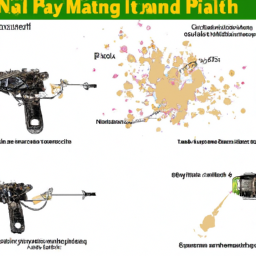How A Paintball Gun Works A Guide
Table of Contents []
How A Paintball Gun Works
How a Paintball Gun Works
Paintball guns, also known as markers, are commonly used for recreational activities such as paintball, airsoft and other types of sports. While the mechanics of these guns can vary based on make and model, understanding how a paintball gun works is essential to safely and effectively participating in paintball and airsoft activities. This article will provide an in-depth and comprehensive introduction to paintball gun mechanics, including its anatomy, firing mechanics, and necessary components to operate a safe but thrilling game of paintball.
Anatomy of a Paintball Gun
The anatomy of a paintball gun consists of several key components: the barrel, the bolt, the hopper, the air tank, and the trigger frame. Each of these components performs a specific function when the gun is discharged. To begin, the barrel is the cylinder-like container that encases the paintball. As the paintball is shot, the barrel guides its trajectory. The bolt functions to unlock the breech of the gun and as the paintball passes through the barrel, it slides up onto the bolt. The hopper is what holds the rounds of paintballs that are fed into the barrel prior to firing. The air tank is the component that supplies pressurized air to the chamber that props up the paintball and allows it to exit the barrel. Finally, the trigger frame is what holds the hopper and barrel together, and what allows the user to pull the trigger to discharge the weapon.
Firing Mechanics
The firing mechanics of a paintball gun are relatively simple. As the user grips the marker and pulls the trigger, the hopper will drop the round of paintball into the barrel of the gun. At the same time, the trigger frame releases a blast of pressurized air into the chamber which propels the paintball out of the barrel. As the user continues to squeeze the trigger, the cycle is repeated and the paintball is fired towards the target.
Components Necessary for Operation
For a paintball gun to operate, several components are required. Primarily, the gun needs an air source to fire. Usually, this is provided by an air tank that is either CO2 or HPA (High Pressure Air) powered. It is important to choose the right type of air compressor for the paintball gun, as using an incompatible type of air tank can cause potentially hazardous problems. Aside from the air tank, the gun also needs paintballs. Paintballs can be bought pre-filled in various sizes, shapes, and colors. Finally, some paintball guns may also require an additional lubricant to keep all moving parts running smoothly.
In Summary
Understanding how a paintball gun works is essential in order to safely and appropriately participate in paintball and airsoft activities. A paintball gun is comprised of several components, including the barrel, the bolt, the hopper, the air tank, and the trigger frame. To function, the gun requires an air source, paintballs, and potentially an additional lubricant. By understanding these key components and their functions, players can safely and accurately operate paintball guns and have an enjoyable experience.

Previous Page
Next Page
